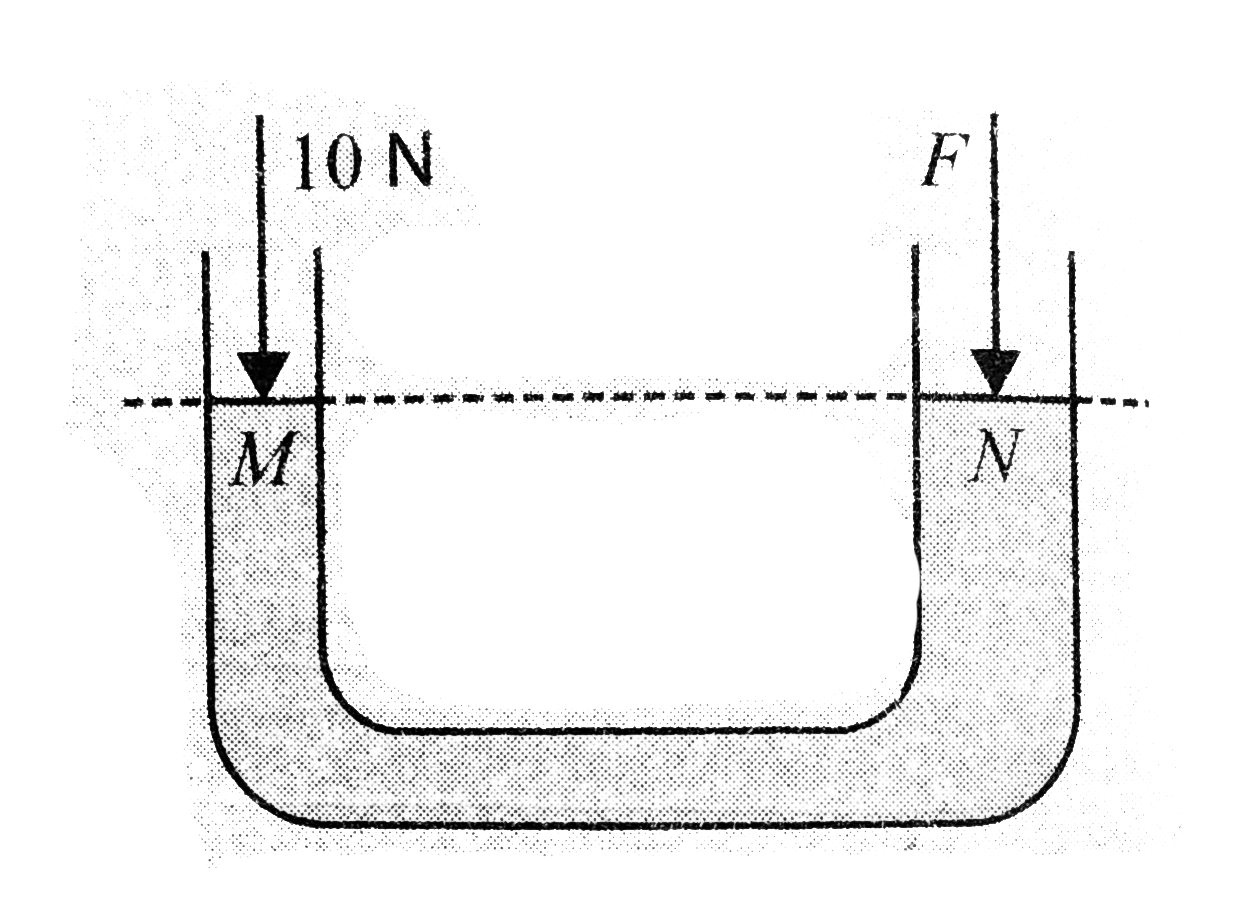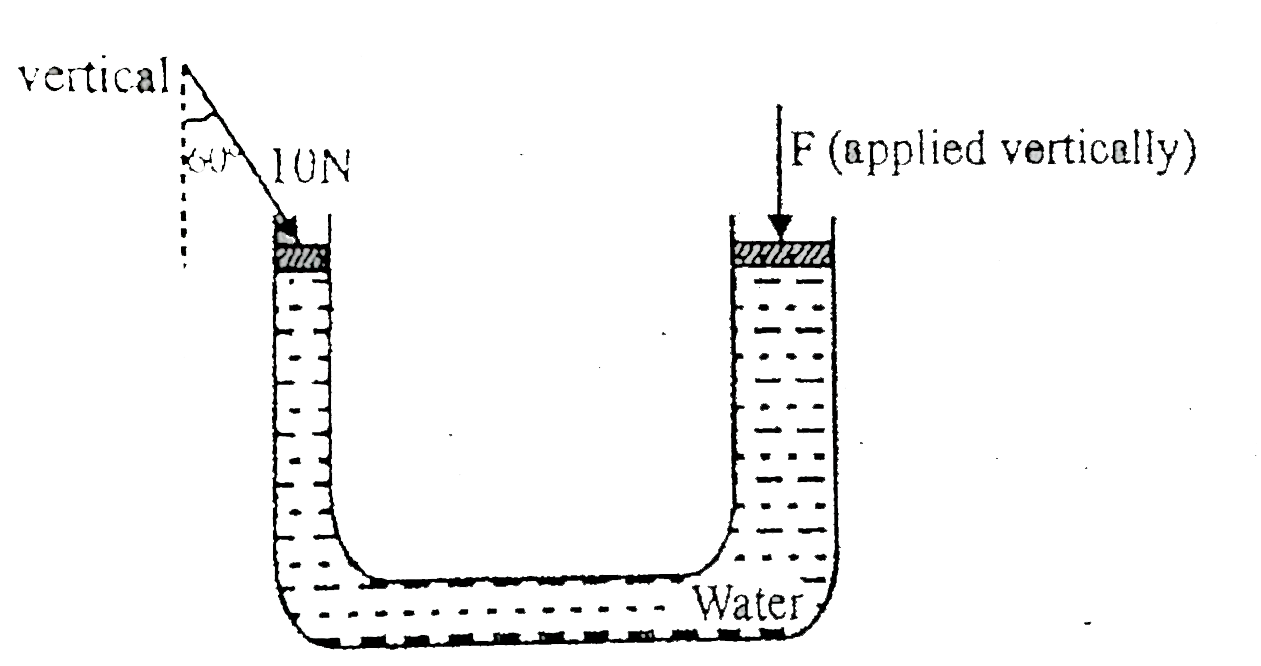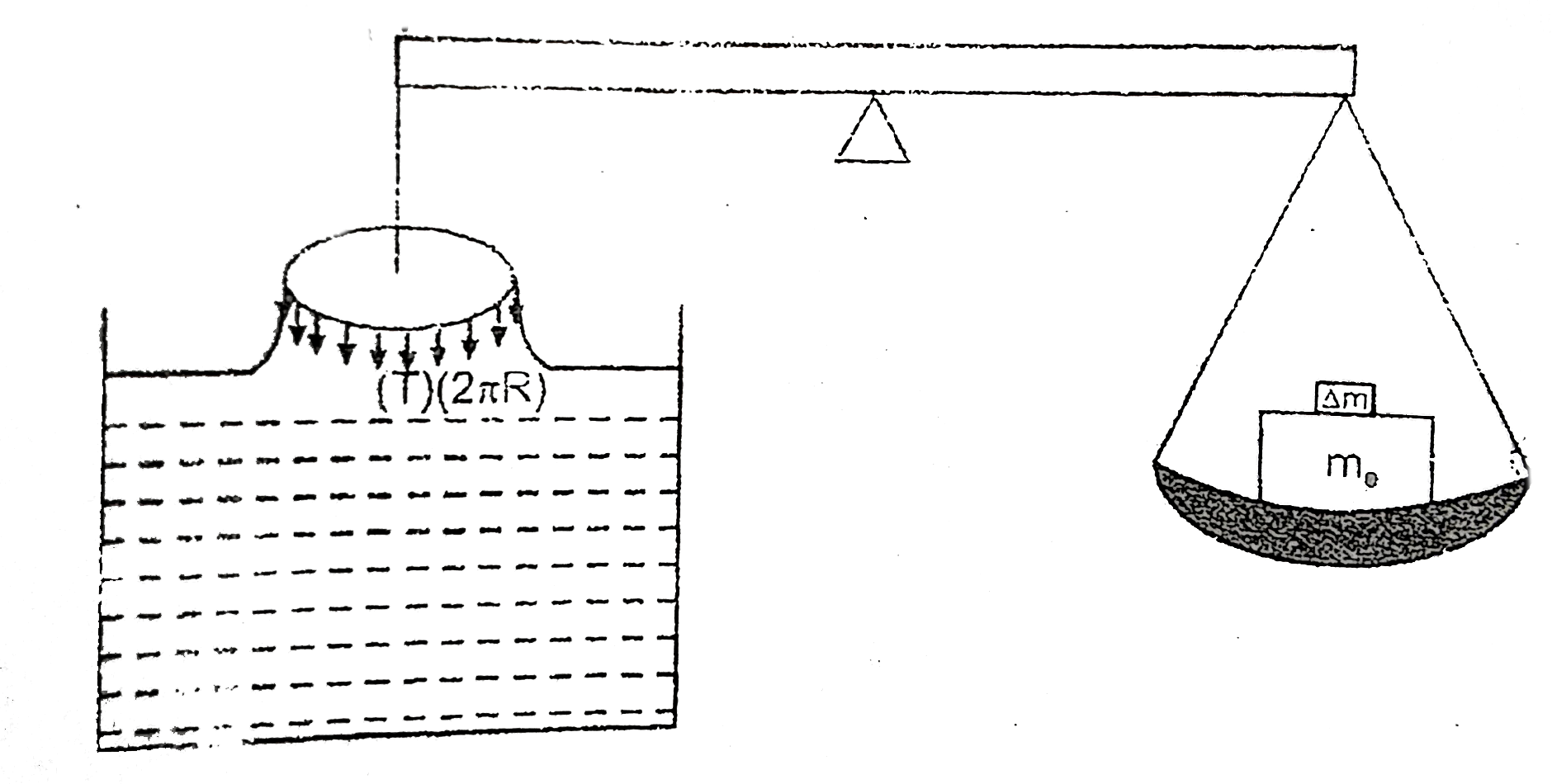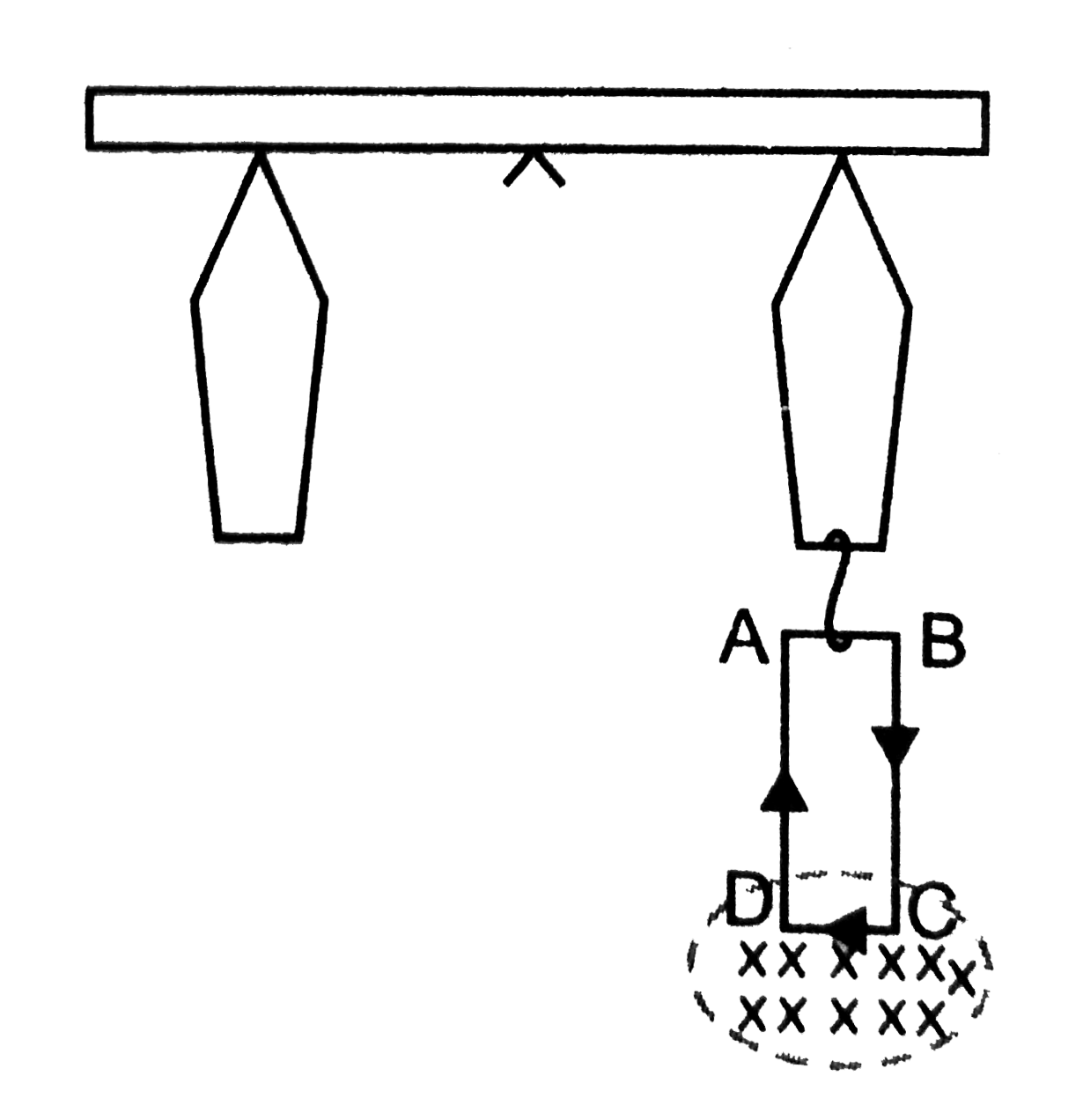The radius of one arm of a hydraulic lift is three times the radius of the other arm. What force should be applied on the narrow arm so as to lift 50 kg at the wider arm?
60 N
54.4 N
26.7 N
30 N
The correct Answer is:B
To solve the problem of determining the force required to lift a 50 kg weight using a hydraulic lift with arms of different radii, we can follow these steps:
1. Identify the Given Values:
- Let the radius of the narrow arm be r.
- The radius of the wider arm is 3r.
- The mass to be lifted on the wider arm is 50kg.
2. Calculate the Weight on the Wider Arm:
- The weight W can be calculated using the formula:
W=m⋅g
- Where m=50kg and g≈9.8m/s2.
- Thus,
W=50kg⋅9.8m/s2=490N
3. Apply Pascal's Law:
- According to Pascal's law, the pressure applied on both arms of the hydraulic lift is equal:
P1=P2
- Where:
- P1=FA1 (Pressure at the narrow arm)
- P2=WA2 (Pressure at the wider arm)
4. Calculate the Areas of the Arms:
- The area A of a circle is given by A=πr2.
- For the narrow arm:
A1=πr2
- For the wider arm:
A2=π(3r)2=9πr2
5. Set Up the Pressure Equation:
- Substitute the areas into the pressure equations:
Fπr2=490N9πr2
6. Simplify the Equation:
- Cancel πr2 from both sides:
F=490N9
7. Calculate the Force F:
- Now compute F:
F=4909≈54.44N
Final Answer:
The force that should be applied on the narrow arm to lift the 50 kg weight at the wider arm is approximately 54.4 N.
---
- Let the radius of the narrow arm be r.
- The radius of the wider arm is 3r.
- The mass to be lifted on the wider arm is 50kg.
- The weight W can be calculated using the formula:
W=m⋅g
- Where m=50kg and g≈9.8m/s2.
- Thus,
W=50kg⋅9.8m/s2=490N
- According to Pascal's law, the pressure applied on both arms of the hydraulic lift is equal:
P1=P2
- Where:
- P1=FA1 (Pressure at the narrow arm)
- P2=WA2 (Pressure at the wider arm)
- The area A of a circle is given by A=πr2.
- For the narrow arm:
A1=πr2
- For the wider arm:
A2=π(3r)2=9πr2
- Substitute the areas into the pressure equations:
Fπr2=490N9πr2
- Cancel πr2 from both sides:
F=490N9
- Now compute F:
F=4909≈54.44N
The force that should be applied on the narrow arm to lift the 50 kg weight at the wider arm is approximately 54.4 N.
Topper's Solved these Questions
- BOOK - AAKASH INSTITUTECHAPTER - MECHANICAL PROPERTIES OF FLUIDSEXERCISE - SECTION - B23videos
MECHANICAL PROPERTIES OF FLUIDS
- BOOK - AAKASH INSTITUTECHAPTER - MECHANICAL PROPERTIES OF FLUIDSEXERCISE - SECTION - C15videos
MECHANICAL PROPERTIES OF FLUIDS
- BOOK - AAKASH INSTITUTECHAPTER - MECHANICAL PROPERTIES OF FLUIDSEXERCISE - TRY YOURSELF41videos
MECHANICAL PROPERTIES OF FLUIDS
- BOOK - AAKASH INSTITUTECHAPTER - MAGNETISM AND MATTER EXERCISE - ASSIGNMENT (SECTION D)26videos
MAGNETISM AND MATTER
- BOOK - AAKASH INSTITUTECHAPTER - MECHANICAL PROPERTIES OF SOLIDSEXERCISE - Assignment(Section-D)12videos
MECHANICAL PROPERTIES OF SOLIDS
Similar Questions
The area of cross section of the two arms of a hydraulilc press are 1 cm^2 and 10 cm^2 respectively figure. A force of 5N is applied on the water in the thinner arm. What force should be applied on the water in the thicker arm so that the water may remain in equilibrium?
 ,View Solution
,View SolutionThe area of cross section of the two arms of a hydraulic press is 1cm2 and 20cm2 respectively. A force of 10N is applied on the water in the thinner arm. What force should be applied on the water in the thicker arms so that water may remain in equilibrium?
 View Solution
View Solution
Knowledge Check
- Question 1 - Select One
Radius of one arm of hyddraulic lift is foud times off radius of other arm. What force should be applied on narrow arm to lift 100 kg?
A26.5 NB62.5 NC6.25 ND8.3 N - Question 2 - Select One
The area of cross-section of the two vertical arms of a hydraulic press are 1 cm2 and 10cm2 respectively. A force of 10N applied. As shown in the figure, to a tight fitting light piston in the thinner arm balances a force F applied to the corresponding piston in the thicker arm. Assuming that the levels of water in both the arms are the same, we can conclude:-
 AF=100NBF=50NCF=25NDF, as applied, cannot balance the effect of the force on the first piston
AF=100NBF=50NCF=25NDF, as applied, cannot balance the effect of the force on the first piston - Question 3 - Select One
A dentist's chair with a patient in it weighs 2100 N . The output plunger of a hydraulic system begins to lift the chair when the dentist's foot applies a force of 55 N to the plunger and the piston . What is the ratio of the radius of the plunger to the radius of the piston ?
A9.3B2.6C6.2D0.64
A thin disc of radius R, just touching the liquid surface forms one arm of a balance. The palte is balanced by some weight on the other side of the balance. How much extra weight should be added on the other side, so that the disc can just come cut of water ?
 View Solution
View SolutionIn a wheel and axle, for one complete rotation the magnitude of displacement of effort is 5 times that of the load. What load can be lifted by applying an effort of 10 N? If the radius of the wheel is 35 cm, what is the radius of the axle?
View SolutionA 100 turn rectangular coil ABCD (in XY plane) is hung from one arm of a balance (figure). A mass 500g is added to the other arm to balance the weight of the coil. A current 4⋅9A passes through the coil and a constant magnetic field of 0⋅2T acting inward (in xz plane) is switched on such that only arm CD of length 1cm lies in the field. How much additional mass 'm' must be added to regain the balance?
 View Solution
View SolutionA car is lifted by a hydraulic jack that consists of two pistons. The diameter of the larger piston is 2 m and that of the smaller piston is 50 cm. If the force applied on the smaller piston is 240 N, find the weight of the car.
View SolutionIn a hydraulic lift, used at a service station the radius of the large and small piston are in the ration of 20:1. What weight placed on the small piston will be sufficient to lift a car of mass 1500kg ?
View Solution

